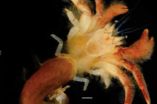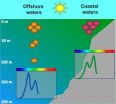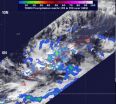(Press-News.org) Areopaguristes tudgei. That's the name of a new species of hermit crab recently discovered on the barrier reef off the coast of Belize by Christopher Tudge, a biology professor at American University in Washington, D.C.
Tudge has been interested in biology his whole life, from boyhood trips to the beach collecting crustaceans in his native Australia, to his undergraduate and PhD work in zoology and biology at the University of Queensland. He has collected specimens all over the world, from Australia to Europe to North and South America.
Until now, he has never had a species named after him. He only found out about his namesake after reading an article about it in the journal Zootaxa. Apparently, finding out after-the-fact is standard practice in the highly formalized ritual of naming a new species.
The two crustacean taxonomists and authors of the paper who named the new crab after Tudge, Rafael Lemaitre of the Department of Invertebrate Zoology at the Smithsonian Institution's National Museum of Natural History and Darryl L. Felder of the University of Louisiana-Lafayette's Department of Biology Laboratory for Crustacean Research, have known Tudge since he first came to Washington in 1995 as a postdoc research fellow at the Smithsonian.
Crustecean Elation
Lemaitre and Felder have been collecting specimens on the tiny Belizean island for decades and for more than 10 years, they had asked Tudge—who specializes in the structures of crustacean reproduction and how they relate to the creatures' evolutionary history—to join them on one of their semiannual research outings.
Finally, in February 2010, Tudge joined them on a tiny island covered with hundreds of species of their favorite fauna.
It was crab heaven for a cast of crustacean guys.
"So you can take 40 steps off the island and you're on the edge of the reef, and then the back part of the reef is what they call the lagoon," Tudge recalled. "You slowly walk out into ever-increasing depths of water and it's a mixture of sand and sea grass and bits of coral, and then there's some channels. There's lots of different habitats there. Some islands are covered by mangroves. So we would visit all the different habitats that were there."
"We would collect on the reef crest, go and turn over coral boulders on the reef flat, snorkel over the sea grass beds. We pumped sand and mud to get things out of the ground. We walked into the mangroves and collected crustaceans from under the mangrove roots. We even snorkeled in the channels in the mangrove islands."
But discovering the new species was much less involved: Tudge turned over a coral boulder in an intertidal area, saw 50 or so tiny crabs scrambling around, and stuck a dozen or so specimens in a bottle before going on with his work.
Only later in the lab, under the microscope, was it determined that this isolated little group of hermit crabs might be unique.
As the journal authors write: "Given this cryptic habitat and the relatively minute size of the specimens (shield length range = 1.0-3.0 mm), it is not surprising that these populations have gone unnoticed during extensive sampling programs that have previously taken place along the Barrier Reef of Belize."
Getting the Word
Tudge found out only recently found out that Areopaguristes tudgei—a tiny hermit crab differentiated from others in its genus by such characteristics as the hairs growing on some of its appendages—was joining the list of about 3 million known species.
Lemaitre emailed him a PDF of the finished article. A note said only, "Here's a new species. What do you think?" The note had a smiley emoticon.
That's the way it works, said Tudge's colleague American University's College of Arts and Sciences, biology professor Daniel Fong. There's no warning; one day you just find out. Fong has also had species named after him, and he has discovered new ones as well.
"You go through several emotions when a species has been named after you," Fong said. "It is truly an honor, in the most formal sense of the term, that your colleagues have thought of naming a species after you. It is a very special type of recognition of your contribution to your research field by your colleagues."
Amid their exhaustive taxonomic description, complete with drawings and photographs of Areopaguristes tudgei, the journal article authors explain why they chose its name: "This species is named after our colleague Christopher C. Tudge (American University) who first noticed and collected populations of this diminutive hermit crab living under large dead coral boulders during joint field work in Carrie Bow Cay. The name also acknowledges his unique contributions to knowledge of the reproductive biology of hermit crabs."
INFORMATION:
American University biologist discovers new crab species
Crustacean becomes professor's namesake
2012-11-27
ELSE PRESS RELEASES FROM THIS DATE:
Study links improved consumer welfare to increased prescription drug advertising efforts
2012-11-27
Athens, Ga. – More people are better off thanks to the impact of an influx of direct-to-consumer advertising spending than they would be without those marketing efforts, according to a study recently published by Jayani Jayawardhana, an assistant professor in the University of Georgia College of Public Health.
The multi-year study focused on advertising efforts surrounding cholesterol-reducing prescription medications. Jayawardhana found increased levels of consumer welfare due to direct-to-consumer advertising than when compared to situations without this type of marketing. ...
SwRI team reports Cassini finds a video gamer's paradise at Saturn
2012-11-27
Call it "PAC-MAN, the Sequel." Scientists with NASA's Cassini mission have spotted a second feature shaped like the 1980s video game icon in the Saturn system, this time on the moon Tethys.
The pattern appears in thermal data obtained by Cassini's composite infrared spectrometer, with warmer areas making up the PAC-MAN shape.
"Finding a second PAC-MAN in the Saturn system tells us that the processes creating these 'PAC-MEN' are more widespread than previously thought," said Dr. Carly Howett, the lead author of a recently published paper in the journal Icarus. "The Saturn ...
IU-led team uncovers process for chameleon-like changes in world's most abundant phytoplankton
2012-11-27
An international team of biologists led by Indiana University's David M. Kehoe has identified both the enzyme and molecular mechanism critical for controlling a chameleon-like process that allows one of the world's most abundant ocean phytoplankton, once known as blue-green algae, to maximize light harvesting for photosynthesis.
Responsible for contributing about 20 percent of the total oxygen production on the planet, the cyanobacteria Synechococcus uses its own unique form of a sophisticated response called chromatic acclimation to fine tune the absorption properties ...
Newly insured patients may have trouble finding primary care physicians
2012-11-27
Implementation of the Affordable Care Act – now assured by the re-election of President Obama – is expected to result in up to 50 million currently uninsured Americans acquiring some type of health insurance coverage. But a study by researchers at the Mongan Institute for Health Policy at Massachusetts General Hospital (MGH) finds that a significant percentage of the primary care physicians most likely to care for newly insured patients may be not be accepting new patients. The investigators note that strategies designed to increase and support these "safety-net" physicians ...
UIC scientists find ancient microbes in salty, ice-sealed Antarctic lake
2012-11-27
Shedding light on the limits of life in extreme environments, scientists have discovered abundant and diverse metabolically active bacteria in the brine of an Antarctic lake sealed under more than 65 feet of ice.
The finding, described in this week's issue of the Proceedings of the National Academy of Sciences, is surprising because previous studies indicate that the brine has been isolated from the surface environment -- and external sources of energy -- for at least 2,800 years, according to two of the report's authors, Peter Doran and Fabien Kenig, both professors ...
Cassini finds a video gamers' paradise at Saturn
2012-11-27
You could call this "Pac-Man, the Sequel." Scientists with NASA's Cassini mission have spotted a second feature shaped like the 1980s video game icon in the Saturn system, this time on the moon Tethys. (The first was found on Mimas in 2010). The pattern appears in thermal data obtained by Cassini's composite infrared spectrometer, with warmer areas making up the Pac-Man shape.
"Finding a second Pac-Man in the Saturn system tells us that the processes creating these Pac-Men are more widespread than previously thought," said Carly Howett, the lead author of a paper recently ...
NASA spots heavy rainfall in Tropical Depression 26W threatening Micronesia
2012-11-27
The twenty-sixth tropical cyclone of the western North Pacific Ocean season formed and has some areas of heavy rain, according to data from NASA's TRMM satellite. Tropical Depression 26W is threatening islands within Micronesia and warnings and watches are currently in effect.
Micronesia is a region in the western North Pacific Ocean made up of thousands of small islands. West of the region is the Philippines, while Indonesia is located to the southwest.
NASA's Tropical Rainfall Measuring Mission (TRMM) satellite passed over Tropical Depression 26W on Nov. 26 at 0526 ...
Scatter radiation from mammography presents no cancer risk
2012-11-27
CHICAGO – The radiation dose to areas of the body near the breast during mammography is negligible, or very low, and does not result in an increased risk of cancer, according to a study presented today at the annual meeting of the Radiological Society of North America (RSNA). The results suggest that the use of thyroid shields during mammography is unnecessary.
"Thyroid shields can impede good mammographic quality and, therefore, are not recommended during mammography," said Alison L. Chetlen, D.O., assistant professor of radiology at Penn State Hershey Medical Center.
During ...
Radiologic and physical findings identify elder abuse
2012-11-27
CHICAGO – Radiologists in Toronto have begun to identify a pattern of injuries that may be indicative of elder abuse, according to a study presented today at the annual meeting of the Radiological Society of North America (RSNA).
According to lead researcher Kieran J. Murphy, M.D., F.R.C.P.C., F.S.I.R., interim radiologist-in-chief at University Health Network in Toronto, Canada, only 2 percent of physical elder abuse is reported by clinicians.
"Unlike cases of child abuse, there is very little information available on this subject," Dr. Murphy said. "It's a much ...
Breast cancer risk estimates increased with repeated prior ct and nuclear imaging
2012-11-27
CHICAGO – Researchers reviewing the records of approximately 250,000 women enrolled in an integrated healthcare delivery system found that increased CT utilization between 2000 and 2010 could result in an increase in the risk of breast cancer for certain women, including younger patients and those who received repeat exams. According to the study, which was presented today at the annual meeting of the Radiological Society of North America (RSNA), nuclear medicine examinations may also contribute to increased breast cancer risk.
CT uses ionizing radiation in the form ...
LAST 30 PRESS RELEASES:
Numbers in our sights affect how we perceive space
SIMJ announces global collaborative book project in commemoration of its 75th anniversary
Air pollution exposure and birth weight
Obstructive sleep apnea risk and mental health conditions among older adults
How talking slows eye movements behind the wheel
The Ceramic Society of Japan’s Oxoate Ceramics Research Association launches new international book project
Heart-brain connection: international study reveals the role of the vagus nerve in keeping the heart young
Researchers identify Rb1 as a predictive biomarker for a new therapeutic strategy in some breast cancers
Survey reveals ethical gaps slowing AI adoption in pediatric surgery
Stimulant ADHD medications work differently than thought
AI overestimates how smart people are, according to HSE economists
HSE researchers create genome-wide map of quadruplexes
Scientists boost cell "powerhouses" to burn more calories
Automatic label checking: The missing step in making reliable medical AI
Low daily alcohol intake linked to 50% heightened mouth cancer risk in India
American Meteorological Society announces Rick Spinrad as 2026 President-Elect
Biomass-based carbon capture spotlighted in newly released global climate webinar recording
Illuminating invisible nano pollutants: advanced bioimaging tracks the full journey of emerging nanoscale contaminants in living systems
How does age affect recovery from spinal cord injury?
Novel AI tool offers prognosis for patients with head and neck cancer
Fathers’ microplastic exposure tied to their children’s metabolic problems
Research validates laboratory model for studying high-grade serous ovarian cancer
SIR 2026 delivers transformative breakthroughs in minimally invasive medicine to improve patient care
Stem Cell Reports most downloaded papers of 2025 highlight the breadth and impact of stem cell research
Oxford-led study estimates NHS spends around 3% of its primary and secondary care budget on the health impacts of heat and cold in England
A researcher’s long quest leads to a smart composite breakthrough
Urban wild bees act as “microbial sensors” of city health.
New study finds where you live affects recovery after a hip fracture
Forecasting the impact of fully automated vehicle adoption on US road traffic injuries
Alcohol-related hospitalizations from 2016 to 2022
[Press-News.org] American University biologist discovers new crab speciesCrustacean becomes professor's namesake



